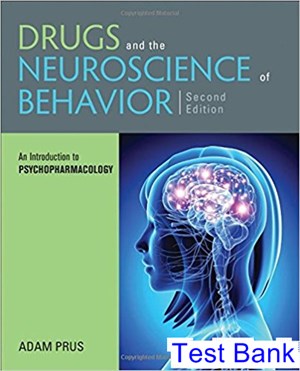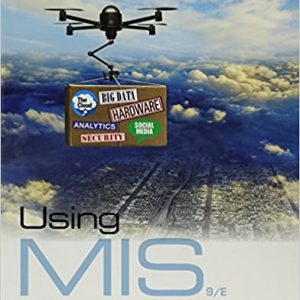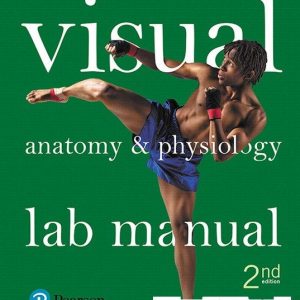Drugs and the Neuroscience of Behavior An Introduction to Psychopharmacology 2nd Edition Prus Test Bank

Product details:
- ISBN-10 : 9781506338941
- ISBN-13 : 978-1506338941
- Author: Dr. Adam Prus
Drugs and the Neuroscience of Behavior: An Introduction to Psychopharmacology, Second Edition by Adam Prus presents an introduction to the rapidly advancing field of psychopharmacology by examining how drug actions in the brain affect psychological processes. The book provides historical background to give readers an appreciation for the development of drug treatments and neuroscience over time, covering major topics in psychopharmacology, including new drugs and recent trends in drug use. Pedagogical features informed by the latest scholarship in teaching and learning are integrated throughout the text to ensure that readers are able to process and understand the material with ease.
Table contents:
1 Introduction to Psychopharmacology Psychopharmacology Why Read a Book on Psychopharmacology? Drugs: Administered Substances That Alter Physiological Functions Psychoactive Drugs: Described by Manner of Use Generic Names, Trade Names, and Street Names for Drugs Drug Effects: Determined by Dose Pharmacology: Pharmacodynamics, Pharmacokinetics, and Pharmacogenetics Psychoactive Drugs: Objective and Subjective Effects Study Designs and the Assessment of Psychoactive Drugs Validity: Addressing the Quality and Impact of a Study Animals and Advancing Medical Research Researchers Consider Many Ethical Issues When Conducting Human Research FROM ACTIONS TO EFFECTS: Therapeutic Drug Development CHAPTER SUMMARY KEY TERMS2 The Nervous System Cells in the Nervous System The Nervous System: Control of Behavior and Physiological Functions Cerebral Blood Flow and Cerebrospinal Fluid Genes and the Physiological Processes of Cells FROM ACTIONS TO EFFECTS: Gilal Scars and Recovery From Brain Injury CHAPTER SUMMARY KEY TERMS3 Neurotransmission Electrical Events Within a Neuron and the Release of Neurotransmitters Nerve Impulses: Electrical Potential Changes in Neurons Propagation of Action Potentials Down Axons Neurotransmitters: Signaling Molecules for Neuronal Communication Neurotransmission: Neurotransmitter Binding to Receptors Different Types of Neurotransmitters and Communication Monoamine Neurotransmitters: Dopamine, Norepinephrine, Epinephrine, and Serotonin Acetylcholine Neuropeptides: A Large Class of Neurotransmitters Nitric Oxide: A Unique Neurotransmitter Other Types of Chemical Transmission in the Nervous System FROM ACTIONS TO EFFECTS: Treating Alzheimer’s Disease CHAPTER SUMMARY KEY TERMS4 Properties of Drugs Pharmacokinetic Properties and Drug Passage Through the Body Pharmacodynamics: Describing the Actions of Drugs Psychoactive Drugs and Receptors Neurotoxins and Damage to the Nervous System Adaptations to Chronic Drug Use FROM ACTIONS TO EFFECTS: Heroin Tolerance and Overdose CHAPTER SUMMARY KEY TERMS5 Drugs of Abuse Regulatory Agencies and Drug Classification Clinical Definitions and the Diagnosis of Drug Addiction Theoretical Models and the Features of Drug Addiction Drugs of Abuse and Reward Circuitry Drug Abuse and Changes to Learning and Memory Systems Neurobiology and the Stages of Drug Addiction Mortality and Drug Addiction Psychological and Pharmacological Therapies for Treating Drug Dependence FROM ACTIONS TO EFFECTS: Food Addiction CHAPTER SUMMARY KEY TERMS6 Psychostimulants Psychostimulants: A Large Variety of Substances Psychostimulants: Herbal Remedies, Prescription Drugs, and Substances of Abuse Pharmacokinetics of Psychostimulants Psychostimulants and Monoamine Neurotransmitters Pharmacological Effects of Psychostimulants FROM ACTIONS TO EFFECTS: Treatments for Psychostimulant Addiction CHAPTER SUMMARY KEY TERMS7 Nicotine and Caffeine Nicotine: Key Psychoactive Ingredient in Tobacco Discovery of Tobacco Tobacco Use and Pharmacokinetic Properties Nicotine and Nervous System Functioning Nicotine’s Potent Pharmacological Effects Nicotine Affects Movement and Cognitive Functioning Environmental, Genetic, and Receptor Differences Between Light and Heavy Tobacco Users FROM ACTIONS TO EFFECTS: Why People Smoke and How They Quit Caffeine Caffeine Absorption, Duration, and Interaction With Other Psychoactive Drugs Caffeine: Antagonist for Adenosine Receptors Caffeine: Mild Psychostimulant Effects Tolerance and Dependence During Sustained Caffeine Use FROM ACTIONS TO EFFECTS: Why People Consume Caffeinated Products CHAPTER SUMMARY KEY TERMS
People also search:
drugs and the neuroscience of behavior 2nd edition pdf
drugs and the neuroscience of behavior pdf
drugs and the neuroscience of behavior an introduction to psychopharmacology





